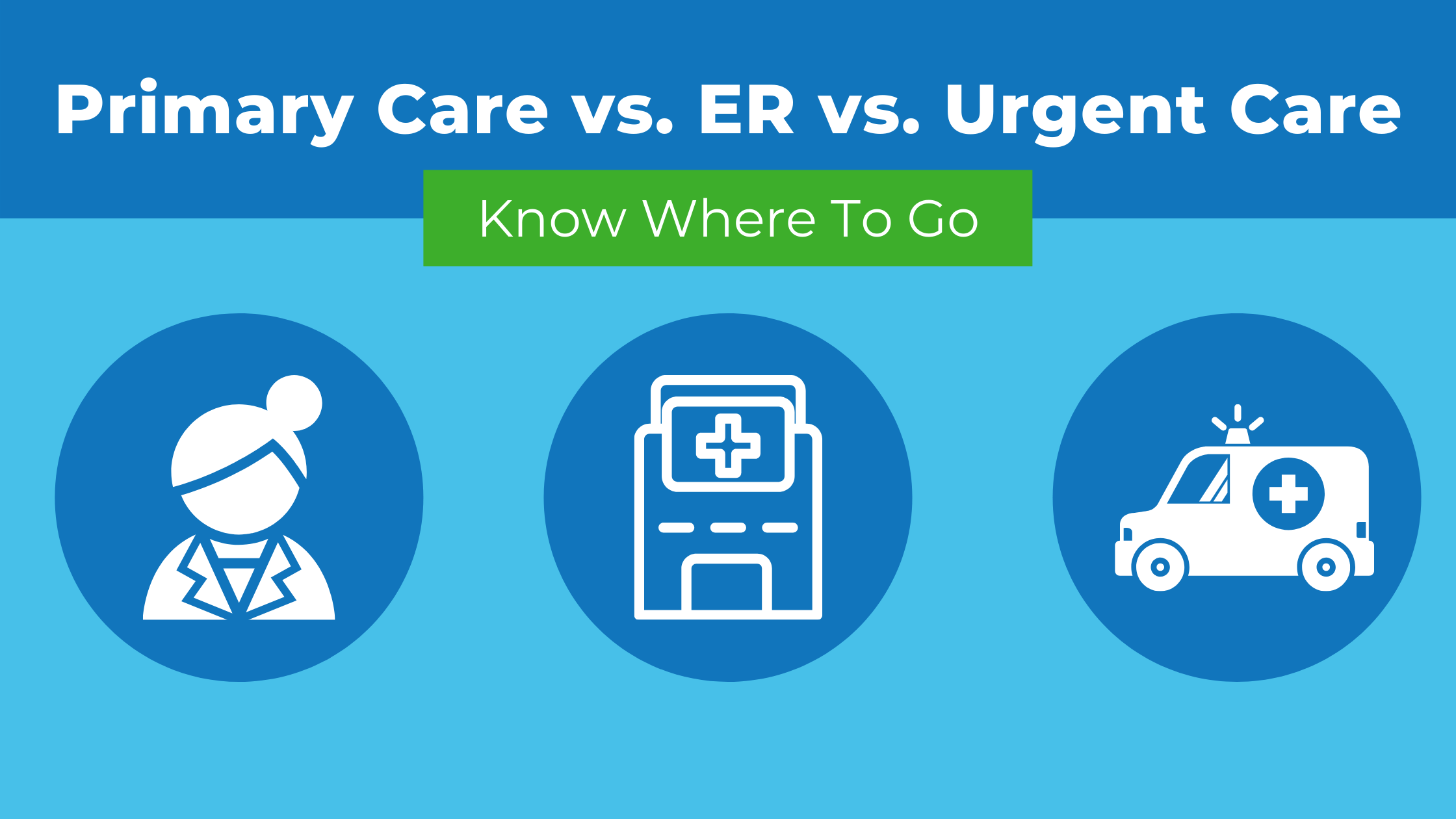
Know Where to Go: Examples of Primary Care vs. Urgent Care vs. ER
When an unexpected health issue pops up, there are a number of things that might race through your mind. One of the first will undoubtedly be, “Where should I go for medical attention?” Depending on what’s happening, you might need to go to an emergency room (ER), urgent care, or a primary care physician (PCP). In this guide, we’ll provide examples of which of these options is best suited to various health concerns.
When to Go to a Primary Care Physician
A primary care physician, also known as a primary care provider, is able to handle a wide range of routine medical concerns. In addition to providing regular physical exams and helping with the management of health conditions like heart disease and diabetes, PCPs can assist with a number of acute medical concerns. These are issues that pop up unexpectedly, but which don’t require emergency care.
The following are examples of health concerns that your PCP can help with:
- Cold and flu symptoms
- Fever
- Cough
- Nausea and vomiting
- Rashes
- Migraines
- Back pain
- Ear aches
- Minor burns
- Minor cuts and lacerations
- Minor strains and sprains
- Insect bites
- Urinary tract infections
These issues can also be handled at urgent care. However, going to your PCP has two important advantages:
- They know your medical history already, which can help them to determine the best course of care.
- Most people choose an in-network PCP, so costs for visits are often less expensive than a trip to urgent care.
Keep in mind that getting a last-minute appointment with a PCP is much easier if you already have an established connection with a physician. If you currently don’t have a PCP, consider setting up an appointment at Bella Terra Primary Care.
When to Go to Urgent Care
Urgent care clinics are designed to help people who need immediate care with an issue that is not life-threatening or that risks permanent disability. Urgent care is an excellent alternative for issues you’d normally see your PCP for but which occur outside of their office hours.
It’s important to note that urgent care is not intended for true emergencies. They are also not designed to be a substitute for having a primary care physician, but rather a backup option when your normal PCP is not available. That’s why it’s so important to find a PCP before these issues come up.
The following are some examples of when you should go to an urgent care clinic:
- Cold and flu symptoms
- Fever
- Cough
- Nausea and vomiting
- Rashes
- Migraines
- Back pain
- Ear aches
- Minor burns
- Minor cuts and lacerations
- Minor strains and sprains
- Insect bites
- Urinary tract infections
Some additional issues that urgent care can assist with include:
- Minor broken bones
- Minor eye injuries
- Dehydration
When possible, go to your primary care physician to address these health concerns. If that option is not available (whether due to the office being closed or no last-minute appointments being available), or if your PCP indicates that they can’t help with that particular issue, go to urgent care instead. Most urgent care centers have a lab and X-ray equipment, so your PCP may direct you there if your issue requires on-site resources that they do not provide.
When to Go to the ER
The emergency room should be reserved for serious health issues which have the potential to cause permanent disability or death. This resource will provide you with the fastest care from doctors who have been trained in dealing with life-threatening injuries and other time-sensitive health concerns.
Go to the emergency department of the nearest hospital if you experience any of the following:
- Difficulty breathing
- Severe allergic reaction
- Fainting, persistent dizziness, or sudden weakness
- Sudden loss of vision, speech, or ability to move
- Sudden, severe headaches
- Sudden confusion
- Seizures
- Broken bones and dislocated joints
- Traumatic injuries of any kind
- Serious burns
- Deep wounds and lacerations
- Heavy bleeding
- Vaginal bleeding with pregnancy
- Coughing or throwing up blood
- Severe pain, especially in the arm or jaw
- High fever, especially with a headache and stiff neck
- Inhalation of smoke or poisonous fumes
- Poison ingestion
- Suicidal thoughts
Some issues are so dangerous that you should call 911 for an ambulance to come to you rather than trying to get to the ER. Examples of these issues include:
- Choking or stopped beathing
- Severe burn
- Severe chest pain
- Head injury with confusion or fainting
- Injury to the neck or spine with loss of movement or feeling
- Any injury that threatens life or limb
One of the advantages of the emergency department is that it is available 24/7. However, you should limit visits to the ER for serious emergencies that need immediate care. If it is something that can wait until your PCP office or nearest urgent care opens, it’s best to choose that option. This ensures that the ER staff can focus their attention on the most serious cases. Although ER visits can be expensive, you should not hesitate to go in a true emergency.
When a health issue arises, don’t let panic get the best of you. Instead, keep this guide bookmarked so you always have a handy reference for where to go for the care you need. If you’re still not sure, you can give us a call at Bella Terra Primary Care during our office hours (Monday through Friday, 9:00 am - 4:00 pm). Outside of office hours, call your nearest urgent care or hospital emergency department.
